-GGMC to do further checks
Mining operations along the Arau River in Region Seven (Cuyuni/Mazaruni) have damaged a section of the waterway, changing the lives of residents of Arau village as they struggle to cope with the environmental degradation and its effects on them.
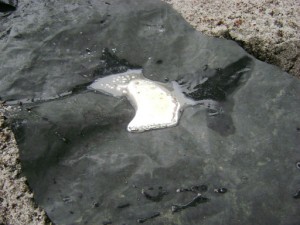
A report dated June 30, 2008 for the Guyana Geology and Mines Commission (GGMC) acknowledged that there had been some environmental damage to the river but differed on other points. When contacted on the issue, GGMC Commissioner, William Woolford told Stabroek News that though commission officials had visited the area, in light of the information brought to his attention by this newspaper, a technical team will visit the area. Woolford noted that the GGMC position is zero-tolerance for operations not in compliance with the regulations.
Arau, a remote Amerindian community, located within the Pakaraimas Mountains, close to the Venezuelan border and comprising about 190 residents from both the Akawaio and Arecuna tribes, is engaged in a court battle to have the area, including the land on which the village is sited, legally recognized as their own. Though the village has legal ownership of a portion of land, the village site, and what villagers say are the traditional hunting and farming areas, are not a part of the titled land. This hunting and farming area, located upriver from the village is also where the mining operations are located and the villagers want these operations to be removed.
However even as the matter continues in court, the mining operations upriver go on, and on a recent visit to the area, Stabroek News observed several breaches of the environmental regulations governing mining, with the villagers having to grapple with the effects of the breaches.
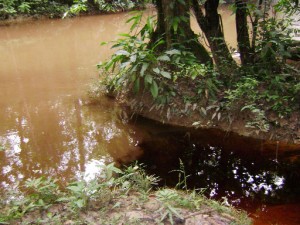
But a recent report done for the regulatory body, which was prompted by a complaint of a resident and a copy of which this newspaper was provided with, however found that there was “no magnitude” to the complaint. The issues raised included the pollution of the river, damage to the land and forest, destruction of the habitat of fish, stagnant water in open pits, possible contamination due to the use of mercury, among others. The GGMC report related to one section of Arau.
However, this reporter’s observations were different. The state of the Arau River, downstream from the mining operations is radically different as compared to the portion upriver from the mines. Upstream, the colour of the water is dark and clean while as it passes through the open mines pits, it changes to a yellowish colour and the water is filled with sediment. Mining has taken place on the river bed itself and sections of the river have been diverted from the original path. Other operations are very close to the waterside and some of the tailings get directly into the river. Mercury is a concern to the villagers too and this newspaper was shown some that was allegedly collected from the tailings. Residents told this newspaper that while the colour of the water had begun to change some years earlier since mining began up the river, it had worsened since 2006 and nothing had changed since though GGMC officials had visited the area several times.
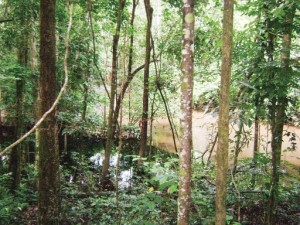
They said that as a result of the polluted state of the river, there is no longer any fish in the water and wildlife affected by the sound of the dredges and the state of the river had moved farther away. The villagers pointed out that the river is their main source of fish and during the dry season, their source of water. They said that as a result of the condition of the river, they have suffered a lot adding that apart from the environmental effects, there are social effects as well.
Miners approached by this reporter at Arau refused to comment on their operations stating that the GGMC had all the reports and this newspaper could get it from the regulatory body. One said that Stabroek News was not in charge of mining. “Ask the warden, he got all the information, he got to know why it happen”, one miner said when asked about the diversion of the river. Towards, the end of this reporter’s visit, some miners stated that while the environment may be an issue, the larger matter was the gold industry’s contribution to the economy.
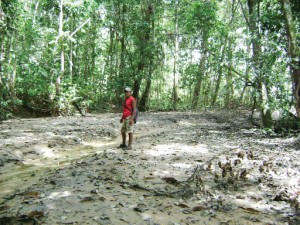
Woolford, meantime, said that the GGMC had visited the area before and noted that there is zero-tolerance for the unsafe use of mercury and muddying of the rivers. “We will go back in”, he declared stating that discussions with villagers would also be held. He noted that the GGMC had visited the area and had dealt with some offenders.
But villagers pointed out that even though Mines Officers visited the area, the condition of the river did not change. They said that it appeared that when the GGMC officers came, the miners stopped their work and resumed when the officer left. On this reporter’s visit to the area, it was observed that a GGMC Officer was on the same flight though he left before this reporter, and with regards to the state of the river, it did not change. Heavy rains later in the week changed the colour of the river water to a lighter yellowish colour and some mining operations were flooded by the high waters and some of the miners left the area, to return, according to reports, in the dry season.
Clashes
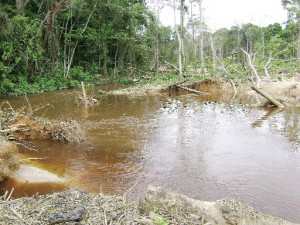
Meanwhile, Devroy Thomas, the chief of the village related that mining in the area started in 2000 and almost immediately there were clashes with them. “They didn’t had no regards for the village council”, he stated. He said that the first mine was very close to the village, at a small stream which became discoloured as a result. The stream ran into the Arau River.
He said that more miners came in and the situation got worse and in 2004 legal action was taken against the owner of the concession. But the lack of monitoring was a factor and saw the activities continuing. More miners followed, including Brazilians and pollution of the river worsened.
The chief related that the effects were especially felt during the dry season with fish dying and aquatic life, in general, affected. He said too that the river water became stagnant and a stench emanated from it. He said as more and more miners came in, the environment was further damaged and apart from that, persons, who had their farms close to the mining areas, had their crops stolen. Residents of the community mostly retain their traditional culture of farming and fishing but some are engaged in artisanal mining in their titled area.
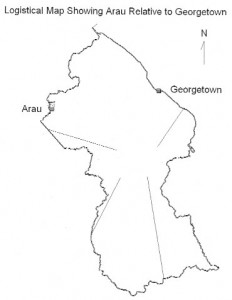
In 2006, Thomas said, the river became further degraded up to the state that it is in now and though several letters were sent to the GGMC, the Environmental Protection Agency (EPA), the Prime Minister and the Ministry of Amerindian Affairs, the situation did not return to normal. Thomas declared that though there were times when GGMC Mines Officers visited, the miners curtailed their operations temporarily. “As soon as they (officers) fly back to Georgetown, that is the time when they will start working again”, he declared. He said that it appeared that enforcement was a problem. “Whenever GGMC observe them throwing tailings into the creek, they would stop most of them but many of them would start back their bad practice of mining”, he asserted.
He noted that those who had their farms close to the river had used it for domestic purposes also but this cannot be done now. “It hard for us to catch fish because no fish can live in polluted water”, he stated. He revealed that as of the present, villagers go further up the river, where the water is clear to catch fish and noted that it has become a smaller part of their diet. During this reporter’s one-week stay in the village, it was observed that the villagers hardly ate any meat and when questioned on this, they said that the limited consumption of fish, a major part of their diet before, was as a direct result of the polluted state of the river. They spoke of finding dead fish floating on the river in earlier years when the mining upriver had commenced, stating that the fish died for no apparent reason and expressed fears about mercury. Mercury is toxic and once released, accumulates in the food chain and its improper use has been a major concern in relation to mining here.
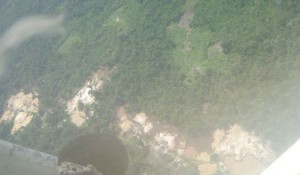
Thomas, who was chief of the village since 1995, said that they were disturbed by the situation. “It is affecting us badly, we are not feeling comfortable with that, we feel it is unsafe, it is interfering with our traditional way of life”, he commented.
He argued that the mining has also affected their hunting as animals no longer came to the polluted river and the sound of the dredges had forced them to move away. He said that though many complaints were made nothing seemed to have been done as the situation remained the same. A recent complaint was made in late April when the village council through the Amerindian Peoples Association (APA) wrote to Prime Minister Samuel Hinds, who is responsible for the mining sector, regarding the environmental damage caused by the mining activities at Arau. The association had also visited the area and had similar findings as this newspaper. In acknowledging the letter, the Prime Minister, in a response to the APA, a copy of which this newspaper has seen, pointed to the fact that a GGMC officer had visited the area on March 26 and had reported problems of high turbidity from mining in the area and “the GGMC is attending to this”.
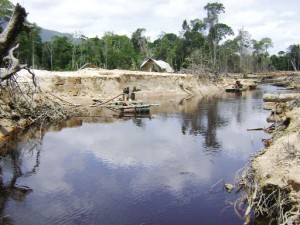
More recently, an area official had referred a complaint about the discomfort suffered by a resident, who lived in his farm, located close to the mining operations, resulting in the GGMC visiting the area to investigate. Following investigations, the effects were found not to be major, the commissioner said.
Woolford asserted that the commission’s information from reports received so far are that operations that had affected persons had stopped working and further declared that officers that would have visited the area would have stopped them.
Changed his life
Stabroek News visited the Arau man on whose behalf the complaint was made. For 75-year-old Kenrick Rudolph, a farmer, whose farm is across the river from a mine, the operations have changed his life. Assisted by translator, and speaking in his native Akawaio language, he said that the miners came some years back and because of the tailings that were thrown into the river and surrounding land during the rainy season, his farm flooded. He said that it happened continuously and he was forced to move as his house too was flooded. He cleared a new area and moved a short distance away, upriver. It was in this area that a portion of the river was diverted earlier this year. Rudolph stated that at that time that he moved, there were no miners up the river but now there are and alleged that at times his camp was broken into and crops stolen.
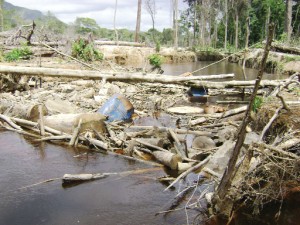
The man recalled that he previously used to fish in the river but could no longer do so and also could no longer use the river for any purpose. He said that before, it was also used for bathing but no longer and several times, he and members of his family had suffered from a skin disorder due to using the river water so they stopped. During the dry season, he said, the situation was worse as a stench emanated from the water. He noted that the noise from the dredges, which he declared operated on a continual basis with pumps removing water from the pits working well into the night, also disturbed them along with the scent of the fuel and the wild animals had all moved farther into the mountains. He stated that he was afraid that the miners would harm him.
He communicated some of these concerns to the GGMC official who investigated the complaint but according to the report miners denied the allegation of stealing crops. With regards to the noise, the miners said that they were not sure if the noise level was intense enough to cause any disturbance during the day and denied working during the night. They said, according to the report, that they started working at about 5 am to pump water from their pits. The miners also said that the residents were poisoning the fish. The report concluded that the complaints were of “no magnitude”. It said that fish habitats may be altered but not destroyed and fish were sighted in the river. It pointed out that upstream, the waterway is in almost pristine condition.
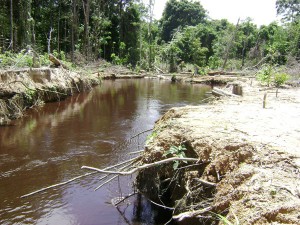
Another farmer in the area that this newspaper spoke with, Daniels Matthews reported similar problems as Rudolph. He said that he was afraid of the miners and some had reportedly told him that they wanted to come onto his land and asked him why the villagers were “greedy” for the land.
Barriers
Stabroek News was told that are about nine mining operations upriver from the village. On a visit to one of the larger operations upstream, it was noticed that a major portion of the river was diverted. Tree roots and dead trees marked the new path of the river. Barriers made out of palm leaves were constructed in an effort to keep the tailings from entering the waterway. At this mine, which was one of the farthest upstream, the colour of the water was brown and appeared to be clean, in contrast to the yellowish colour of the water further downstream. The GGMC report said that the colour of the water revealed some appreciation for the water quality noting that earlier turbidity results for that area measured 65.4 NTU (turbidity units). No tests were carried out for the report. Turbidity relates to the state of the water due to sediments or foreign particles stirred up or suspended in the water. In relation to mining, water with a NTU of 30, which would be barely cloudy to the eye is the standard required for discharge into waterways under the regulations
Woolford asserted that any miner not operating in accordance with the regulations would have been stopped. “We insist that miners must comply with the law at all times”, he declared. While the report acknowledged that the river had been diverted from its original course, it said that this had not been done recently.
Another concern raised by the villagers was mercury. They said that the miners used this in a haphazard manner including in the sluice boxes and discharged the tailings directly into the river. Caleb Peters, a miner from the village showed this reporter a small bottle filled with the chemical and related that he had found this in the tailings, when he went to the mines to “spin battel” there. The amount was about four ounces. Peters, who said that he frequently went to the mines, stated that he had observed as the miners used the mercury. “They wash the gold in buckets in the creek and when they pump it, the quicksilver (mercury) float up”, he stated. “Some does float like powder on the water top and the fish does eat it up”, he added. “Sometimes is sheer silver (mercury) you find in the water”, he declared. He related that he went to spin his battle in a mined out pit, near to the river and he scooped up gravel from the waterside. “I spin it and I see sheer silver”, he stated. He said that some had fallen back into the river and from his impression there was a large amount of the chemical in the gravel in the creek.
While residents were not generally knowledgeable about the effects of mercury, they knew that it could be dangerous. Jacklyn King said that said that she was afraid of getting “cancer from eating the fish”. She said that the GGMC had spoken to the villagers about mercury and its effects. The woman declared that her life was made harder because of the pollution of the river and had watched as the condition of the waterway changed. “It was clear, black water and then it start getting nasty, brownish…it start getting worse and worse”, she stated. She said that apart from going farther and farther to search for water during the dry season the villager’s diet was also affected. “We used to eat plenty meat in those times, now we have to buy salt fish”, she commented.
Meanwhile, Woolford said that the mines officers had had the water tested before and had anything been wrong, the operations would have been stopped. No tests for mercury were carried out during the mining officer recent trip. Noting that investigations were done and the necessary action taken, Woolford referred to a complaint about the river, where the GGMC established what the situation was and took corrective action. Asked about the muddy water he stated that “whenever miners are not in accordance with the law we stopped them”. He pointed out that the GGMC had visited the area and “we dealt with whatever matters had surfaced”.
He noted, however that the commission is always concerned when there is discontent. “We are always concerned where there is discontent”, he declared emphasizing that the GGMC position is zero-tolerance for mining without the consent of surface rights holders. The regulatory body head assured that there is zero-tolerance for the unsafe use of mercury and muddying of the rivers. “We will go back in”, he told this newspaper stating that a technical team will be sent in to review the operations and also meet with villagers. He pointed out that the GGMC visited the area four times in three months and had got the impression that there had been no problems with mining. He declared that if any operations were in breach of the mining regulations, cease-work orders would be issued and they would be warned of prosecution.
It was also observed that at some old mines, the pits were not back-filled and the GGMC report noted that mining inevitably alters the landscape and forest and most of the negative impacts can be mitigated by better mining practices such as back-filling. It added that open pits “form new habitats for other species that cannot survive in flowing water such as tadpoles. They can also be used for aqua-culture”. The report done for the GGMC recommended that complaints “be screened properly before any attempt to launch an investigation since it’s a waste of the commission’s time and money when inaccurate information is given to the commission”. It said too that the Arau mining area should be analyzed for mercury to satisfy concerns of the complainant and boundaries for reservations, farms and mining permits must be marked on the ground.
Meantime, the villagers said that the GGMC should take a closer look at some of the operations. “At least they should visit the area on a more regular basis”, Thomas stated. He declared that what is needed is a permanent GGMC station in the area as more miners were moving in all the time. He added that more “power” needs to be given to a mines ranger, stationed in the nearby village of Kaikan. According to the chief, the miners seem not to respect the ranger, given what he said was his “limited power”. Thomas said that from his information, reports are sent to the GGMC “but nothing never happens” and the ranger needs more authority. He said that the mines officer that visited at the time of this newspaper’s trip was the third such for the year by the GGMC.
Residents were unanimous in their view that the miners be moved and the river restored to its original state. “We want the government to take action and the GGMC to stop issuing concessions on the village and around the titled area”, Thomas said.
“We feel that the government should take more serious action against these miners, they are violating the laws of the Mining Act”, he added.
Recently, both the Prime Minister and the GGMC commissioner had strongly stated that the time for the education of miners with regards to the environment had passed and it is the time for sanctions to the applied to errant miners.









